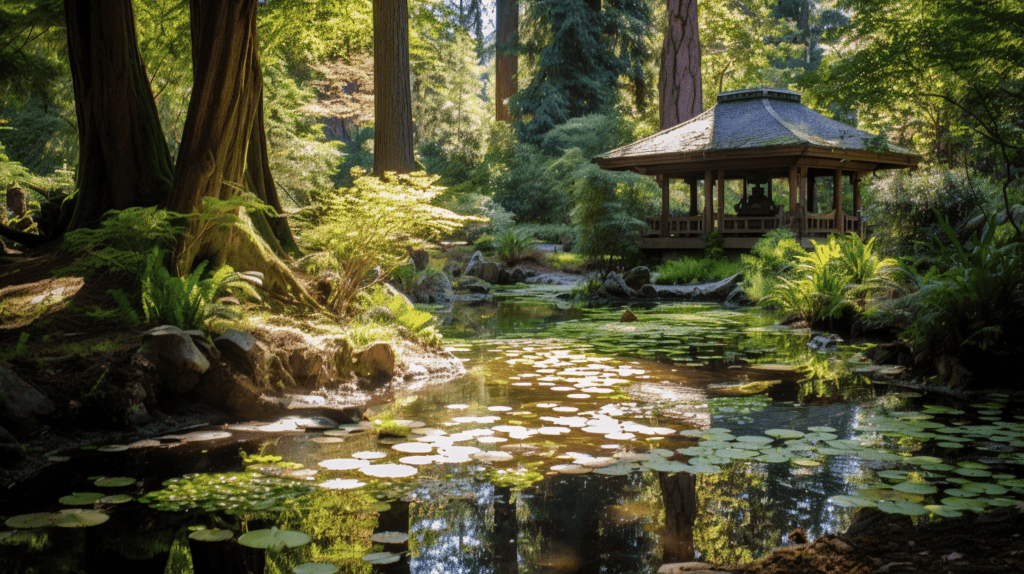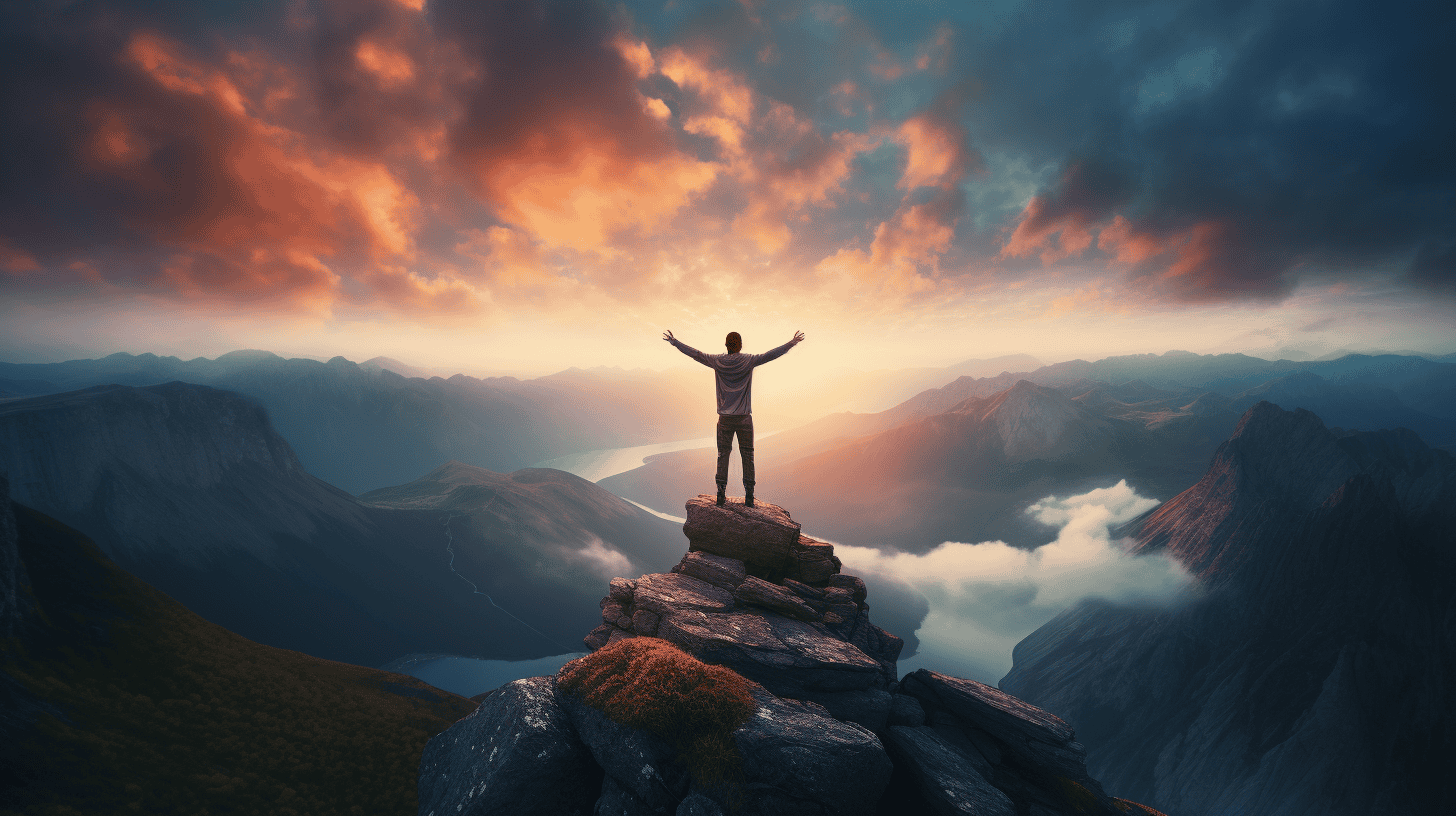Are you yearning to deepen your spiritual meditation practice but feel stuck or unsure how to proceed? I’ve felt frustration and confusion before finding my way through research and committed practice.
This article is a roadmap that will guide you on your journey inward, shifting from basic mindfulness exercises to profoundly deep states of awareness. Get ready to unravel the mystery as we delve into the depths of your spiritual meditation voyage!
Key Takeaways
- Start by focusing on an anchor, such as your breath or a mantra, to cultivate mindfulness and presence in the present moment.
- Practice observing your thoughts without getting attached or caught up in them, letting them flow and go. This helps develop detachment from the constant chatter of the mind.
- Explore gaps of no thought during meditation, moments of silence and stillness that bring deeper connection with your inner self and profound insights.
- Embrace nothingness, a state free from mental formations or conceptual thinking. Experience pure consciousness devoid of content for a profound sense of awareness.
- Transition from object-focused meditation to self-inquiry by becoming conscious of being conscious. Let go of identifications with external objects and circumstances to discover the essence of who you are.
- Cultivate an attitude of non-attachment and let go, inviting deeper connection through gentle observation and surrendering into the present moment.
- Dwelling in the state of being involves letting go of identifications and recognizing awareness as the backdrop for all activities. It brings a more profound sense of peace and connectedness with yourself and the world.
The Initial Stages of Spiritual Meditation Practice
“The mind is by nature restless. Begin liberating it from its restlessness; give it peace, make it free from distractions, train it to look inward, and make all this a habit.” – Ramana Maharshi
The first step in starting a form of meditation is to commit to making this a regular practice. There will be days when you want to give up. Remember what is on the other side of the chaos: your authentic self.
It is time to take a spiritual experience, and the first step is choosing an anchor that will allow you to release thoughts. Let’s dive in!
Focusing on an anchor
Picking an anchor is the first step. It helps to keep your mind from wandering off. Your breath or a body sensation can be a good choice for this.
Even the sound of a ceiling fan will work as an anchor. You want to focus on an object that doesn’t stimulate the mind. This will help deepen your meditation practice.
You won’t need to think hard about it. Do it gently and quickly; you will feel less confused and more at peace.
Understanding awareness without thought
I find peace in the quiet. My thoughts stop racing for a while. This is when I touch my true self, right at the heart of stillness. Here, thought falls away, and only awareness remains present.
It’s pure knowing without thinking about it – understanding that unfolds independently. Meditation lets me rest in this space where thoughts are not needed to be aware. Focusing on breath or noise in the room leads me to this spot of clarity, where ideas don’t shape my world anymore. Just pure awareness does it all.
Observing and letting go of thoughts on your spiritual journey
Letting go of our thoughts is not easy. But on our journey of spirituality, it’s crucial. We often hold on to thoughts and beliefs with a tight grip. This can close us off from genuinely diving into deeper layers of self-awareness.
In meditation, we learn to watch our thoughts come and go without grabbing onto them or pushing them away. Think about watching clouds pass by in the sky. You notice each one but don’t try to hold on to them or change their shape or speed.
It’s just like that with our thoughts during mindfulness meditation practice.
It does not mean we stop thinking when we meditate! Instead, we become more aware without getting stuck in any specific thought or idea. This increases our ability for conscious breathing and be present in the moment.
And remember, every thought that comes is okay! Good, bad – they are all allowed here because this place has no judgment.
Moving Towards No Thought and Nothingness

In this stage of your spiritual meditation journey, you will explore the concept of no thought and embrace the state of nothingness. To access gaps of no thought, allow yourself to become fully present in the moment.
Let go of any attachment or identification with thoughts that arise. Instead, observe them without judgment and gently release them. This practice helps cultivate a deeper sense of awareness and presence.
As you continue meditation, you may also become aware of nothingness – a state free from mental clutter or distractions. Embrace this experience by allowing yourself to rest in pure awareness without getting caught up in thoughts or emotions.
Recognize that beneath the surface fluctuations lie a vast and expansive emptiness that is always accessible.
Moving towards no thought and nothingness requires patience and practice. It’s important not to force these states but to invite them through gentle observation and surrendering into the present moment.
By cultivating an attitude of non-attachment and letting go, you can deepen your connection.
Accessing gaps of no thought for your spiritual awakening
In meditation, there is a stage where we can access gaps of no thought. This means finding moments of silence in our minds, where thoughts are temporarily absent. It’s not about stopping thinking completely but recognizing that awareness doesn’t always require constant thinking.
As we continue to practice and go deeper into meditation, we may start to observe periods of nothingness or a lack of thoughts. These gaps offer us a glimpse into the stillness and clarity beyond our usual thoughts.
Becoming aware of nothingness and your higher self

As I continue my spiritual path, I find myself delving deeper into the practice and experiencing new levels of awareness. One significant aspect is becoming aware of nothingness.
Initially, my mind was filled with random thoughts during meditation. But as I refocused my attention repeatedly, I started to notice moments of silence and stillness in between thoughts.
Gradually, these gaps became more prevalent, and I began to experience a sense of nothingness or emptiness. This awareness allowed me to let go of identification with thoughts and attachments, creating space for a deeper connection with pure awareness itself.
Transitioning to Self-Awareness
In this stage of your spiritual meditation journey, you will transition from object-focused meditation to self-inquiry. It’s a shift towards becoming aware of being conscious and exploring the depths of your existence.
This is where the true transformative power of meditation begins to unfold.
“When some great teachers of the past reflected on the rarity of human existence, they did not even feel like sleeping; they could not bear to waste a moment. They put all their energy into spiritual practice.” – Dilgo Khyentse
As you deepen your practice, you’ll notice that it’s not just about focusing on an anchor or observing thoughts; it’s about turning inward and discovering the essence of who you are.
This transition requires a willingness to let go of identifications with external objects and circumstances and instead recognize awareness as the backdrop for all activities.
One technique that can help facilitate this transition is self-awareness meditation. This involves shifting your attention from external objects or sensations to a deeper exploration of your consciousness.
By noticing the observer within you, by becoming conscious of being conscious, you begin to peel back layers and uncover a more profound understanding of yourself.
During self-awareness meditation, it can be helpful to ask yourself questions such
Becoming conscious of being conscious
As we continue our spiritual path, we reach an essential phase of becoming conscious of being conscious. This transition involves moving from object-focused meditation to self-inquiry.
“Everything we say, do, and think, aligns us with darkness or light, love or grievance. Thus everything is a spiritual practice, whether we are aware of it or not.” – Ted Dekker
At first, we may be aware of random thoughts, but as we refocus our attention repeatedly, we become aware of nothingness. It is through this process that we begin to recognize and become aware of awareness itself.
By letting go of identifications and attachments to thoughts or emotions, we can exist in the state of being. Recognizing that awareness is the backdrop for all activities helps us diminish our identification with the body and the external world.
As a result, we can experience a more profound sense of connection and peace within ourselves.
Moving from object-focused meditation to self-inquiry
When we practice meditation, we often start by focusing our attention on an anchor. It could be our breath, a mantra, or a specific sensation. This helps us cultivate concentration and mindfulness.
- Refocus our attention: We shift from random thoughts to a single point of focus. This could be observing the breath or sensations in the body.
- Cultivate awareness without thought: We become aware of the gaps between thoughts. In these silent moments, we connect with pure awareness that is beyond our thinking mind.
- Letting go of identification: We recognize that thoughts and sensations come and go, but awareness remains constant. We detach ourselves from identifying with our thoughts and emotions.
- Self-inquiry: We explore “Who am I?” or “What is the nature of consciousness?” These contemplative questions deepen our understanding of ourselves and expand our awareness.
- Embrace stillness: By dwelling in this state of self-inquiry, we experience moments of stillness and peace within ourselves. We rest in the present moment without clinging to thoughts or external distractions.
Dwelling in the State of Being

Dwelling in the state of being is a crucial stage in your spiritual journey. It involves letting go of identifications and recognizing awareness as the backdrop of all activities.
In this state, you can experience a more profound sense of peace and connectedness with yourself and the world around you. It requires practice and patience, but it can be gratifying.
To dwell in the state of being, start by letting go of any labels or identities you may have attached to yourself. These could be roles like parent or employee or personal attributes like introverted or ambitious.
By releasing these identifications, you open yourself to experiencing your true essence beyond these external markers.
Next, bring awareness to the present without getting caught up in thoughts or judgments. Recognize that thoughts come and go like clouds passing through the sky, but your essential nature remains unchanged.
This shift in perspective allows you to cultivate a sense of inner stillness and peace amidst the chaos of everyday life.
Letting go of identifications
Letting go of identifications is an essential step in your spiritual meditation journey. It involves detaching from your ego and realizing that you are more than your thoughts, emotions, and physical body.
By recognizing that awareness is the backdrop of all activities, including thinking, you can diminish identification with the temporary aspects of yourself and the external world. This process allows you to experience a more profound sense of spiritual connection and move beyond the limitations of your ego.
Letting go of identifications takes time and practice, but it can lead to a profound shift in how you perceive yourself and the world around you.
Recognizing awareness as the backdrop of all activities
In my spiritual meditation journey, I understand the importance of recognizing awareness as the backdrop of all activities. This means that instead of identifying with my thoughts, emotions, or physical body, I focus on the underlying awareness every moment.
Doing so allows me to detach myself from temporary and changing aspects of life and connect with something deeper and more enduring. This recognition allows me to let go of attachments and be fully present in the here and now, experiencing peace and clarity.
It also helps me shift my perspective from being one small individual in a vast world to being part of a larger interconnected whole.
Discerning the Changeful and the Unchanging
In this stage of your spiritual meditation journey, you will learn to distinguish between what is temporary and what is eternal. This discernment is crucial in deepening your understanding of the true nature of reality.
By recognizing the impermanence of constantly changing things, you can begin to connect with the unchanging essence within yourself and all beings. This awareness allows for a sense of stability and peace amidst the ever-changing world.
It also helps cultivate a profound sense of interconnectedness and oneness with everything that exists. Through this practice, you can tap into a deeper level of wisdom and insight that transcends the limitations of our ordinary perception.
Distinguishing between what is temporary and what is eternal
In our meditation practice, we must recognize the difference between what is temporary and what is eternal. This involves understanding that everything, including our thoughts and emotions, is subject to change.
However, there is something within us that remains constant and unchanging – our awareness or consciousness. By recognizing this unchanging aspect of ourselves, we can diminish our identification with the ever-changing body and external world.
This helps us cultivate a more profound sense of peace and contentment as we connect with the eternal nature of our being.
Progressing at Your Own Pace
Progressing at your own pace is essential in your spiritual meditation journey. It’s important to remember that everyone is different and will progress at their speed. There is no need to rush or compare yourself to others.
Instead, focus on finding a practice that feels comfortable and resonates with you.
Take the time to explore different meditation techniques and find what works best for you. Whether it’s mindfulness meditation, loving-kindness meditation, or visualization meditation, choose a practice that aligns with your goals and preferences.
By practicing what feels natural and enjoyable, you’ll be more likely to stick with it over time.
As you continue your journey, allow yourself room for growth and maturation through consistent practice. Just as physical exercise requires time and dedication to see progress, so does spiritual meditation.
Be patient during resistance or difficulty; they are part of the process.
Remember that progress doesn’t always happen linearly. Some days may feel incredibly profound, while others may seem lacking.
Practicing what is comfortable
In meditation, it’s essential to go at your own pace. Don’t push yourself too hard or try things that make you feel uncomfortable. Find what feels good and comfortable for you. This could mean focusing on your breath, using a mantra, or sitting still.
Remember, there is no right or wrong way to meditate as long as it works for you. By practicing what is comfortable, you can deepen your meditation and find peace within yourself.
Allowing oneself to mature through practice
As we embark on our spiritual meditation journey, we must remember that progress and growth happen at our own pace. Each practitioner is unique and will have their path towards maturity in their practice.
It’s crucial to honor ourselves by practicing what feels comfortable and authentic. Through consistent practice, we can cultivate deep levels of self-awareness and uncover new layers of understanding within ourselves.
There is no set timeline or expectation for how fast we should progress; it’s about embracing the present moment and trusting the process. The School of Awakening offers support and resources for those looking to deepen their meditation practice along this transformative journey.
Conclusion on how to deepen your spiritual meditation
In conclusion, diving into the depths of your spiritual meditation journey requires patience and practice. By focusing on an anchor, observing and letting go of thoughts, accessing gaps of no thought, and transitioning to self-awareness, you can deepen your meditation experience.
Dwelling in the state of being and discerning between the changeful and unchanging will further enhance your journey. Remember to progress at your own pace and allow yourself to mature through practice.
With dedication and commitment, you can unlock the transformative power of meditation in your life.
Q: What is spiritual meditation?
A: Spiritual meditation is a practice of meditation that focuses on deepening your spiritual awareness and connecting with your higher self. It involves going beyond the physical and mental aspects and seeking a deeper connection to the spiritual realm.
Q: How can I deepen my spiritual meditation?
A: There are several ways to deepen your spiritual meditation practice. Some of them include regular meditation and contemplation, taking an online course or joining a spiritual meditation group, exploring different techniques such as kriya meditation, and seeking guidance from experienced spiritual directors.
Q: What are the benefits of spiritual meditation?
A: Spiritual meditation can bring numerous benefits, including spiritual growth, a sense of inner peace and well-being, increased mindfulness and self-awareness, a deeper connection to your higher self, and a greater sense of purpose and meaning in life.
Q: How do I practice spiritual meditation?
A: To practice spiritual meditation, find a quiet and comfortable space where you won’t be disturbed. Close your eyes, take a few deep breaths, and focus your attention on your breath or a mantra. Allow your mind to become still and observe any thoughts or sensations that arise without judgment. Gradually deepen your practice over time.
Q: What is the difference between spiritual meditation and regular meditation?
A: While regular meditation focuses primarily on relaxation, stress reduction, and mental clarity, spiritual meditation emphasizes the connection to the spiritual realm and the exploration of one’s higher self. It delves deeper into the spiritual aspects of meditation.
Q: Can anyone practice spiritual meditation?
A: Yes, anyone can practice spiritual meditation. It is not limited to a specific religious or spiritual tradition. It is a personal practice that can be adapted and customized according to an individual’s beliefs and needs.
Q: What are some popular spiritual meditation techniques?
A: Some popular spiritual meditation techniques include mindfulness meditation, loving-kindness meditation, kriya meditation, transcendental meditation, and guided meditations focusing on spiritual themes.
Q: Is it necessary to have a spiritual director for practicing spiritual meditation?
A: Having a spiritual director is not necessary for practicing spiritual meditation, but it can be beneficial for those seeking guidance and deeper understanding in their spiritual journey. A spiritual director can provide insights, support, and personalized guidance tailored to individual needs.
Q: Are there any specific resources or organizations that can help me in my spiritual meditation journey?
A: Yes, some various resources and organizations can assist you in your spiritual meditation journey. Ananda Worldwide, Tiny Buddha, and certain online courses and meditation centers led by experienced teachers are some examples.
Q: What is the role of stillness in spiritual meditation?
A: Stillness is an essential element in spiritual meditation. It helps you let go of distractions and external noise, allowing you to focus inward and connect with your higher self. Stillness creates an environment conducive to deep reflection, insight, and spiritual awakening.





Leave a Reply